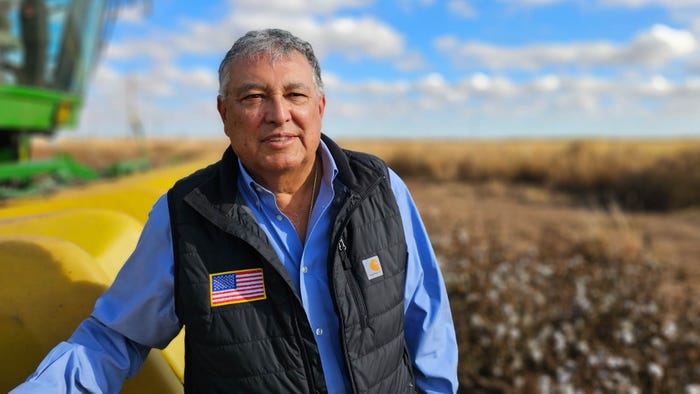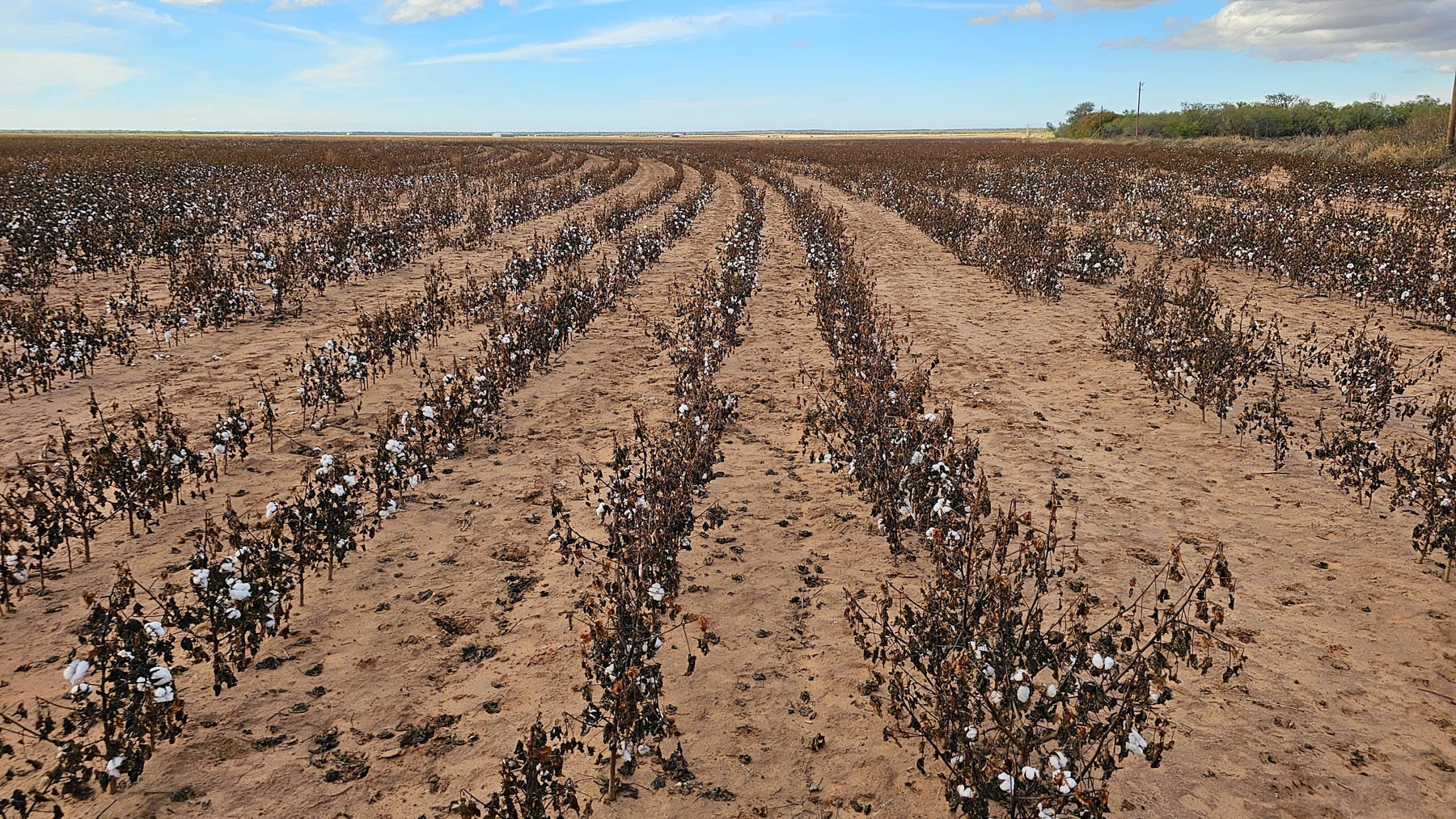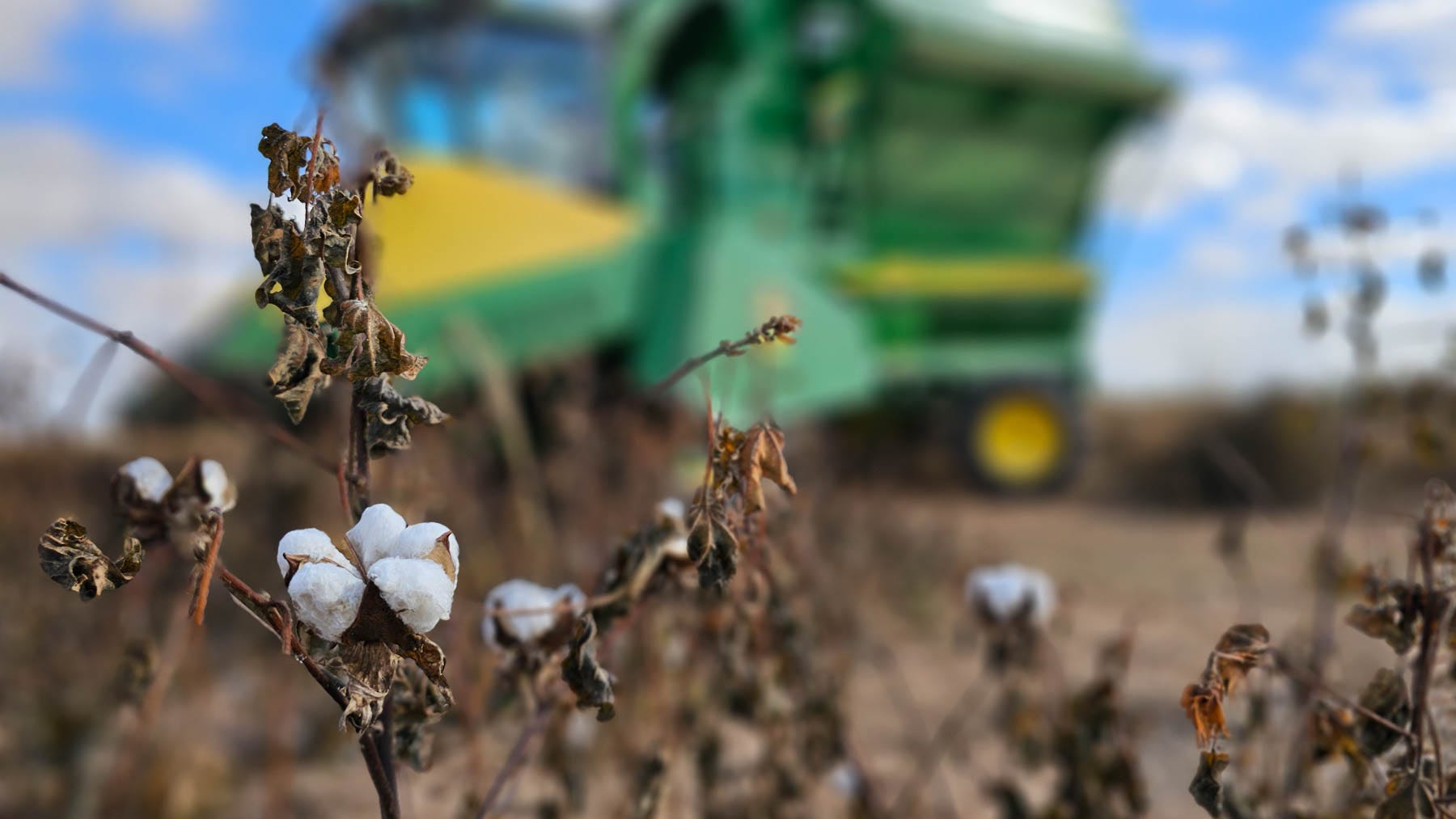
Roby, Texas, producer Richard Gaona says in his 46-year career, he's never had a season quite like this one. Shelley E. Huguley
An October freeze on the Texas Rolling Plains delivered a final blow to an already suffering cotton crop. This time of year, fields are typically blanketed with white cotton bolls. But this season, darkened and dead vegetation has left what resembles a black eye on the region, as the remnant white fiber is hidden beneath the leaves.
For a crop that started with such promise, Roby, Texas, producer Richard Gaona, says it’s spent most of the season in survival mode. “We're harvesting,” he says as he strips the sparse crop. “It's not very good. But it's irrigated, so we're going to get what we can.”

Richard Gaona and his wife Judy farm near Roby, Texas. (Photo by Shelley E. Huguley)
Before he climbed into the cab, he rolled dry, dead cotton leaves, which were also somewhat rubbery due to the humidity, between his hands. He’s wavered between turning his primarily dryland crop into insurance or harvesting what remains.
“Because of the price of cotton, we’re right at that deal of ‘Which is the right decision?’ Do you harvest it and take it to the gin and see what you make? Or take the 50 to 70 pounds from the crop adjuster? Either way, it’s going to cost you.”
He’s decided to harvest it, plus ginning it will help the gin, he adds.
But Gaona knows he’ll take another hit at the gin. “The leaves froze on (the cotton). Normally, we would have put some type of defoliant on there to knock the leaves off and we just weren’t prepared. We didn’t think it was going to get that cold. We needed a few more days.”
He drew attention to the dark cloud billowing from his cotton stripper, explaining it’s not a basket fire but caused by the trash and dead leaves. “A lot of leaf is going to hurt us at the gin,” he says. “Excess trash is going to cost us.”
The October 30th freeze also locked any potential for unopened, immature bolls to add to yields. “Whatever’s opened is all we’re going to get. Everything else is out.”
Another blow is the cotton price. “That will be another ding.”
Skip-row cotton
Gaona grows skip-row, dryland and drip-irrigated cotton. The vast majority of his acres are dryland. Skip-row, he testifies, “always produces cotton.”

Skip-row dryland cotton. (Photo by Shelley E. Huguley)
He says, “If it rains this winter, and with spring rains, it’s going to be skip-row. It always produces, no matter what.”
Promising #plant23
Planting moisture this year, kicked off a season with “a lot of promise.” Coming off a poor, drought-stricken 2022 crop, planting rains and a high emergence rate provided a brief reprieve and hope.
In response to the moisture, as Gaona strip-tilled he applied a full rate of fertilizer on both his irrigated and dryland ground. “We had enough moisture at the time. It looked like it would work.”
Mother Nature had other plans.
"Everything was planting good," Gaona says. "Everything was coming up and looked really good and then June 21, we got that Matador tornado storm with the wind and rain.”
The storm blew in and washed away a lot of the region's crop, destroying "that young cotton in the cotyledon stage,” Gaona says. “By the time it was time to replant, we decided not to. It was still too wet.”
From the stripper cab he pointed out bare spots in the irrigated field. “The sand, from that June storm, did some damage to this cotton, that’s why it’s not very good here. As you get into the field, you’ll see where the cotton is a little taller. Even though we had wheat as a cover crop, the wind was so strong it damaged the cotton.”

Richard Gaona's father taught him when you plant a crop, you take it to harvest. (Photo by Shelley E. Huguley)
The summer's heatwave also threw repeated blows. "We didn't realize it was going to turn completely dry from June until the latter part of August, first of September. And with 100-degree days, whatever cotton was left, had a time because of the heat."
He agreed cotton likes heat but not consecutive, 100-plus degree days and 85-degree nights. "It needs time to cool down," he says.
As the heatwave persisted, he stopped fertilizing. “We did spray for weeds, but we didn’t do much of anything else. We kept the water on it, but like I said, we’re getting short of water and our water quality is not very good. We’re getting more salt in it because of the lack of rainfall.”
Dryland yields
In years past, Gaona says they’ve pulled up to 1,200 pounds of cotton on his dryland fields. This year, he anticipates about 180 pounds. “We’ll see once we get in here. But as far as getting out here and shredding it, I can’t do that.
“I was taught that when plant a crop, you take it to harvest.” And that’s exactly what he’ll do.
About the Author(s)
You May Also Like






